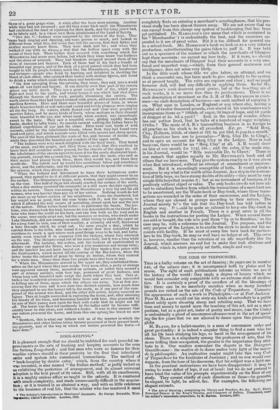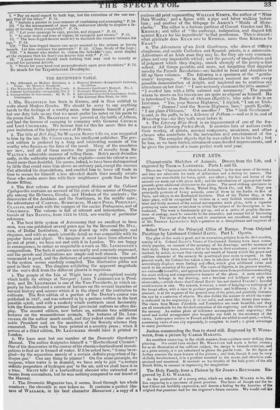THE CODE OF TERPSICHORE.
THIS is a bulky volume on the art of dancing: its pages are in number
548, of the octavo size ; it is accompanied both by plates and by music. The sight of such publications informs us where we are in
the history of the world : they imply a degree of luxury which we would fain consider only compatible with an extreme state of civilization. It is certainly a proof of the overflow of all the blessings of life : there can be no raendicity societies when so many hundred pounds are risked on the sale of the Code of Terpsichore. Conceive the appearance of such a work in Philadelphia—or at Port Jackson Poor M. BLASIS would cut his sixty-six kinds of entrechats to a public intent solely upon shearing sheep and retailing soap. That we have
time and money to spend upon the teaching of this art, not as a mere pastime, but as a great art, sister of poetry and music, (see the Code,) is undoubtedly a proof of uncommon advancement in the art of spending the few years that we are allowed to dance upon this pirouetting globe.
M. BLASIS, for a ballet-master, is a man of uncommon order and great profundity : it is indeed a singular thing to find a man who has
all his life been studying his legs, so lucid in the arrangement of his
ideas. There is a singularity among the professors of arts, that the more trifling their occupation, the greater is the importance they attri bute to it. Our readers remember the dispute in the Bourgeois Gentilhomme : the maitre de la danse makes very light of the mac ire data philosophic. An inattentive reader might take this very Code of Terpsichore for the Institutes of Justinian and no one would ever
suppose, from the tone of his discourse, that his subject was a light one. In the practical instructions we have been disappointed : it may be owing to some defect of legs, if not of head : but we do not pretend to have tried the value of his precepts experimentally on the floor of our study. They consist chiefly of such directions as these—be graceful, be elegant, be light, be adroit, &c. For examples, the following are elegant extracts.
* The Art of Dancing ; comprising its Theory and Practice, &c. &c. By C. Bias% Principal Dancer at the King's Theatre, and Composer of Ballets. Translated, under the author's immediate inspection, by B. Barton. London, WM I. "Pay an equal regard to both legs, lest the execution of the one surpass that of the other. P. 52. "Imitate a painter in your manner of combining and arranging." P. 54. III. "In the management of your legs, endeavour chiefly to acquire a faCllity of turning them completely." P. 58. IV. ".Let your openings be easy, precise, and elegant." P. 60. V. "In your steps and terns of vigour, be energetic and strong." P. 61. VI. "The bow-legged dancer must try to diminish the vacuum between his legs." P. 62. .VII. "The bow-legged dancer can never succeed in the serious or heroic branch. Let him embrace the pastorale." P. 62. (Chap. Study of the Legs.) VIII. "A dancer who wishes to charm the beholder's eye, must display all the elegance that his fancy can inspire him with." P. 65. IX, " A-good dancer should omit nothing that may ':end to remedy or conceal his personal defects. X. "Never let your head rest perpendicularly upon your shoulders." P. 72. So much for the Terpsichorean Decalogue.



















 Previous page
Previous page